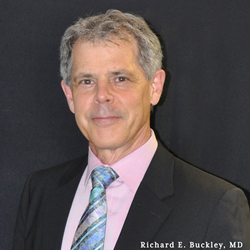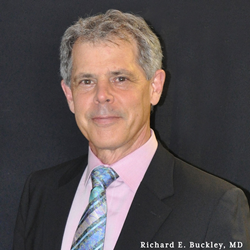
Kelly Ripa recently revealed she underwent earlobe reconstructive surgery. Dr. Richard E. Buckley discusses why torn earlobes is not the only reason clients are seeking out this surgical procedure.
Whether the earlobe is stretched purposely or accidentally over time due to heavy earrings or trauma, they can be reduced and reshaped to have pleasing, natural-looking contours, and, more excitingly, normal functionality with the ability to wear earrings again.
MILFORD, Pa. (PRWEB)
March 09, 2020
When people think about reconstructive earlobe surgery it’s most often thought of in relation to the early 2000 trend for “gauged” earlobes, which is a body modification where an individual would stretch their ears by continually using slightly larger jewelry to create larger than typical pierced holes. But “gauged” or purposely super-sized earlobe holes are not the only reason individuals are seeking out earlobe reconstructive surgery. “At MilfordMD there has been an increase in men and women requesting repair of their earlobes. In most cases it is due to earrings having partially or wholly torn the earlobes. Mostly not because the person purposely stretched their earlobes, but rather because of a history of wearing heavy earrings,” says Dr. Richard E. Buckley Cosmetic Surgeon and Medical Director of MilfordMD Cosmetic Dermatology Surgery & Laser Center in Milford, Penn.
During the Live with Kelly and Ryan! Fashion Finder segment on Instagram TV, Kelly Ripa shared that her earholes were torn all the way through as a result of wearing hanging earrings for years. “When this happens, it’s disheartening for patients. We frequently find out that a patient has gone fifteen to twenty years without earrings because of their torn earlobe. They are very excited to hear it can be repaired and that they can resume wearing earrings immediately following surgery,” according to Dr. Buckley.
In 2018, the ninth top cosmetic surgical procedure was earlobe surgery according to The American Society for Aesthetic Plastic Surgery revealing that it is a highly requested surgical procedure with 60% female patients and 40% male patients.
“Whether the surgery is desired because of distorted earlobes due to gauging or a result of years of heavy, hanging earrings, earlobe reconstructive surgery involves repairing the earlobe through and through. It’s not just the surface of the front of the ear that is repaired. It’s also the thickness of the ear where the scarring is removed and the backside of the ear where the ear is repaired. There is usually a bunch of scar tissue that is removed at the same time,” says Dr. Buckley.
Earlobe reconstructive surgery takes about thirty minutes per ear or one hour to repair both earlobes. The procedure uses local anesthetic, so patients are comfortable with minimal discomfort and are able to resume daily activities immediately following their surgery. Dr. Buckley recommends avoiding unclean water such as swimming pools and the ocean for two to three weeks following the surgery to minimize any infection risks.
For this type of reconstructive surgery, Dr. Richard E. Buckley taps into his surgical and artistic skills to re-shape the lobe. “The goal of this surgery is a normal contour of the earlobe. It’s important to craft the earlobes so they are aesthetically pleasing and natural-looking. The surgical process, crafting how the scarring is removed, and how the new fresh edges are put together is truly individualized. It’s in that process of individualization that the contours are restored,” says Dr. Buckley.
When reconstructing the earlobe, it’s not as simple as just sewing the top and bottom piece together. First, the healed part where the earring pulled through is removed. And the inner edges must be freshened as scar tissue can’t be pieced together. The scar tissue is removed so there is nice, fresh healthy skin to sew together. And it’s not simply two flat surfaces that are pieced together. Little steps or grooves in the shape of the letter ‘Z’ are made on each side, matched and stitched together, according to Dr. Buckley.
In the past, patients would have to wait until the repair healed before placing a new earring stud. Now, Dr. Buckley places new gold earring stud during the procedure. “What I often find is that the original earring placement is not truly symmetrical if you measure it,” says Dr. Buckley, “I make sure the new earring placements are truly symmetrical for patients.” Aftercare is a key component to a successful surgery. Patients need to turn the stud daily and keep antibiotic on the front and back side of the surgical area while it heals.
“There are many ways of crafting the earlobe repair so it is much stronger after surgery,” states Dr. Buckley. “It requires some finesse and utilization of fancy techniques which patients can’t really appreciate since it’s all inside the ear. But it makes a difference in how it heals and the future durability of the repair. This is where a surgeon’s skills and artistry come into play and that can make all the difference in the result.”
About MilfordMD Cosmetic Dermatology Surgery & Laser Center:
The MilfordMD Cosmetic Dermatology Surgery & Laser Center offers state-of-the-art highly specialized procedures in laser and cosmetic surgery and aesthetic skin care. In addition to its AAAHC nationally accredited surgical center and extensive laser surgery capabilities, MilfordMD offers physician designed skin care products for home use. Milford Pennsylvania’s MilfordMD Cosmetic Dermatology Surgery & Laser Center is sought out by patients from around the world for expertise and innovation in cosmetic treatments performed by Board Certified Physicians, Richard E. Buckley, M.D. and Marina Buckley, M.D.
MilfordMD Cosmetic Dermatology Surgery & Laser Center is located at 303 W. Harford Street, Milford, PA 18337. Tel: (570) 491-1962. For real patient video testimonials, follow MilfordMD on Instagram and Facebook, and visit our MilfordMD YouTube channel.
Share article on social media or email:

